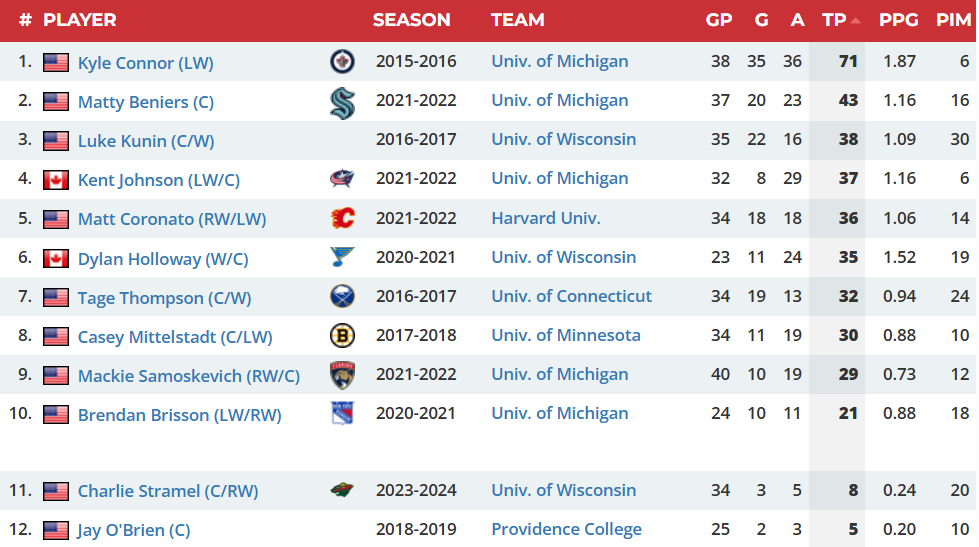When Porter Martone fell in the Flyers lap at pick number six, there was always a chance they were going to be unwitting participants in junior hockey’s newest study: how good can CHL imports really be at the college level?
Starting this season, players who had previously played in the Canadian Hockey League will be eligible to join NCAA programs. Before this year, CHL as a whole was considered a “professional league”, due to some players who have already signed their NHL entry-level deals.
So Martone, along with other CHL standouts like Michael Misa and Gavin McKenna, will be the first to make the jump to the collegiate ranks, with very little in the way of prior examples to measure up against.
The best comparison that can be drawn to whatever Martone might be during his freshman year at MSU, is to other first rounders who played their draft plus-one years in college. Here’s a list of all the D+1 NCAA newcomers over the past 10 seasons:

Of course, none of these players came from the CHL, in fact, most came from the USHL, save for Kent Johnson and Dylan Holloway, who both played in lower level Canadian junior leagues below the CHL level, thereby maintaining their eligibility.
Mostly, there’s just some good results here, most guys hovered around a point per game, save for a really productive shortened season from Dylan Holloway, and Kyle Connor’s insane 2015 at Michigan. Most of these guys, it’s fair to say, did not come with the draft pedigree of someone like Porter Martone, the only ones who did were Kent Johnson, Matty Beniers, Casey Mittelstadt, and generously we can say Connor too.
They all also played in leagues that, in the opinion of most scouts and observers, are worse quality than the OHL. The OHL, at least up to this point, has usually had a much more dense concentration of talent than leagues like the USHL, and obviously is at another level compared to alternative Canadian junior leagues like the Alberta Junior Hockey League. Martone has dominated the OHL for the majority of his career in Brampton, and is coming into the college ranks having played against some of the stiffest competition available to him in North America.
Given that reality, he should be coming into his time as a Spartan with a full head of steam, and there’s a good chance that he really won’t need that long of an adjustment period compared to players from lesser leagues, he’s used to physicality and playing at a quick pace. There’s a good chance that some nights, he won’t even notice a step-up in competition.
When you analyze it in that framework, it’s easy to get excited about the prospect of Martone dominating the college ranks, especially when he’s playing on an MSU team that will have the likes of other first and second round talents like Cayden Lindstrom, Ryker Lee, Trey Augustine, and the Flyers’ own Shane Vansaghi playing alongside him. Whatever line combinations they decide to go with, Martone will be playing alongside at least one potential NHLer, and on a power play that will be loaded for bear.
While it’s hard to truly grasp how any of the CHL to NCAA imports will do in their debut seasons, Martone’s unique combo of size and skill makes him a perfect prototypical fit for the league, and after a career of dominance, he should feel confident in his ability to continue that pace. While it may be wishful thinking to predict a point per game or more, out of the likes of draft eligible standout Gavin McKenna, Ducks prospect Roger McQueen, and the rest of the litany of CHL players to make the jump, Martone might be the best equipped to make the most of this new opportunity.
Either way, there will be an unprecedented influx of talent in NCAA hockey this upcoming season, and the Flyers may have the best of the best.